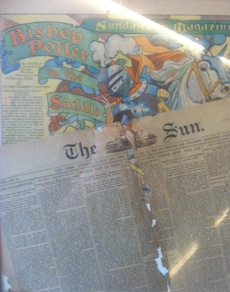The Skyscraper Museum is devoted to the study of high-rise building, past, present, and future. The Museum explores tall buildings as objects of design, products of technology, sites of construction, investments in real estate, and places of work and residence. This site will look better in a browser that supports web standards, but it is accessible to any browser or Internet device.
NEWSPRINT

These newspaper fragments were found between the walls of a bank building in Hartford, Connecticut.
The color of this show is mostly beige and brown because of the deteriorated condition of late 19th-century newsprint and other wood pulp papers. Historians generally associate the post-Civil War boom in newspaper circulation with sensationalist journalism, but the availability of cheap wood pulp as the primary ingredient of newsprint was as much the cause.
Prior to the 1860s, all newspapers were printed on rag paper made primarily from cotton and linen. As the prices of these materials began to skyrocket in the early 19th century, alternative ingredients were sought. By the 1870s, nearly all New York newspapers were printed on newsprint that contained some wood pulp, and by the 1880s, newsprint was made entirely of wood pulp, usually from poplar and willow. Spruce, with its longer and lighter-colored fibers, became the favored source by the 1890s.
The results of the introduction of wood pulp to the newspaper industry were dramatic. Between 1890 and 1900, the total circulation of metropolitan dailies nearly doubled, prices per newspaper dropped, and many editions increased in the number of pages. The New York Times cost two cents in 1883 and the Post and Tribune were cut to three cents apiece after increasing in size to eight pages the same year.
The newspaper industry prospered from the introduction of wood pulp paper, and the morning and evening editions of inexpensive newspapers became a necessary part of everyday urban life. Today, though, newsprint of the late 19th century, unlike earlier still-white rag paper broadsheets, is brown and brittle, disintegrating into paper dust like these examples of the Sun and the World.
